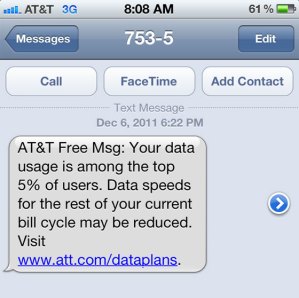 AT&T announced that it would revise its policy for unlimited data plan holders, following recent criticism over a lack of transparency in those plans. Going forward, subscribers that surpass 3 gigabytes of usage in a billing cycle will be subject to a reduction in download speed, a practice known as “throttling.” Prior to the announcement, data throttling occurred only for the top 5 percent of data users, and based on geographic location and network load, according to AT&T — factors that users found difficult to independently verify or predict.
AT&T announced that it would revise its policy for unlimited data plan holders, following recent criticism over a lack of transparency in those plans. Going forward, subscribers that surpass 3 gigabytes of usage in a billing cycle will be subject to a reduction in download speed, a practice known as “throttling.” Prior to the announcement, data throttling occurred only for the top 5 percent of data users, and based on geographic location and network load, according to AT&T — factors that users found difficult to independently verify or predict.
As AT&T said in a statement to CNET on Thursday, “Our unlimited plan customers have told us they want more clarity around how the program works and what they can expect.”
AT&T has begun publicly addressing the alleged need for further wireless spectrum in handling its increased network traffic, following the closely watched collapse of its attempted merger with T-Mobile USA. The terms of that deal would have seen AT&T acquiring T-Mobile’s valuable wireless bandwidth, in addition to its customer base, creating the largest US wireless carrier. Instead, AT&T was forced to concede billions of dollars worth of its own wireless spectrum to T-Mobile, following the intense regulatory scrutiny that forced AT&T to abandon the merger.
AT&T explained its decision to throttle unlimited data customers by citing that “their data usage is significantly higher than those on tiered plans. For example, in January, the top 5 percent of our unlimited data plan customers used an average of over 50 percent more data than the top 5 percent of customers on tiered plans.”
However, last week we covered a report published by the wireless research firm Validas, which found that the top 5 percent of unlimited data users in fact consumed almost exactly the same amount of data as the top tiered monthly users — or those subscribers who have a capped monthly allowance of data.
More likely, AT&T is attempting to future-proof its own network in anticipation of the explosion in data use new 4G LTE devices will introduce. Currently 4G phones make up a small percentage of AT&T’s overall customer base — but that is expected to change quickly as competitors such as Verizon and even T-Mobile build out their own LTE networks over the next year. Still, AT&T’s current policy looks to be more about moving legacy customers to increasingly profitable tiered plans than about current network needs. To this point, according to the new plan, AT&T’s unlimited 4G subscribers will have a higher threshold for throttling — 5 gigabytes — due to that technology’s higher bandwidth use.
AT&T has reportedly been toying with unconventional ways to juice more money from its broadband infrastructure: One idea had John Donovan, AT&T’s chief of network technology, proposing app developers pay for the data their apps use. He likened the plan to toll-free calling, saying “A feature that we’re hoping to have out sometime next year is the equivalent of 800 numbers that would say, if you take this app, this app will come without any network usage,” according to The Wall Street Journal.
Currently, AT&T has about 17 million “unlimited” data users. If that figure is accurate, roughly 850,000 users will potentially be affected by the new throttling policy.
All the major US wireless carriers except Sprint participate in some form of throttling of unlimited users: T-Mobile throttles after 5 gigabytes, and Verizon does it based on the top 5 percent of users but only when a specific local cell tower is congested with heavy network traffic.
For the vast majority of wireless data users, 3 gigabytes of use is a long way off — the average American smart phone consumed just 435 MB in the first quarter of 2011, according to Nielson. Put that in perspective though, and the rate of growth is actually quite astounding: Consumption was up 89 percent since the first quarter of 2010, when average data use was less than 230 MB.
Editors' Recommendations
- AT&T customers past and present impacted by huge data leak
- How to check data usage on an iPhone or iPad
- T-Mobile suffers massive data breach … again
- Relax, the EU’s scary USB-C rule won’t rob you of fast-charging benefits
- How to pre-order the OnePlus 10T


